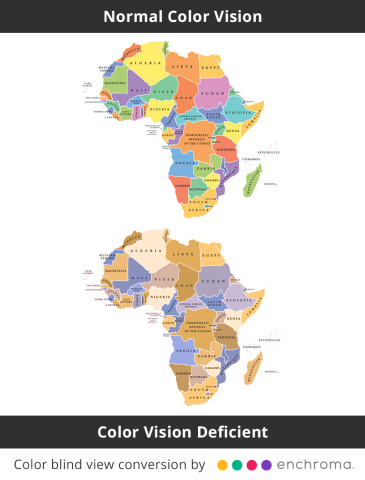BERKELEY, Calif.– EnChroma – creators of glasses for color blindness – today released the results of a landmark study that clearly demonstrates the negative effect color blindness has on learning for millions of students. The data strongly indicates that schools are failing to identify color blind students and that parents, educators and legislators need to better support these students.
In early 2020, nearly 1,000 color blind people, including the parents of color blind children, shared their opinions about how Color Vision Deficiency (CVD) affected their educational experiences. Seventy-eight percent said they were often frustrated or confused by colors in school assignments and activities. One in three say color blindness affected their confidence in school, and 30% felt like they might be a “slow learner” before discovering they’re color blind.
A contributing factor is the lack of testing for color blindness in schools. According to EnChroma, only 11 of 50 states test for CVD. As a result, many students do not realize they’re color blind. In fact, nearly half of color blind people said they didn’t learn they’re color blind until after 7th grade, almost one in three while in high school or later, and one in five don’t find out until after high school or college.
“The evidence is overwhelming that color blindness creates learning challenges for color blind students and that parents, educators, and politicians must become more aware of the prevalence of color vision deficiency, and its impact, and take action,” said Erik Ritchie, CEO of EnChroma. “Too many kids go deep into their educations without the student, their parents or teachers knowing they’re color blind. Testing for color blindness has to become universal in schools in all states and countries, and learning materials adapted to accommodate and create a level playing field for CVD students.”
One in 12 men (8%) and one in 200 women (.5%) are color blind – 13 million in the US, 30 million in Europe, and 350 million worldwide. For them, understanding colorful information in school, at work and in daily life can cause obstacles. While people with normal color vision see over one million shades of color, the color blind only see an estimated 10% of hues and shades. Common color confusions include green and yellow, gray and pink, purple and blue, and red and brown, with colors appearing muted and dull. Since 80% of information is conveyed visually, this creates issues for color blind students.
Numerous renowned universities plan to offer EnChroma glasses to color blind students to borrow on their campuses, and to educate staff to adapt materials to accommodate CVD students. They include Boston University, North Carolina State University, Alfred University and Francis Marion University, with others joining soon.


